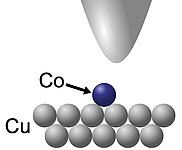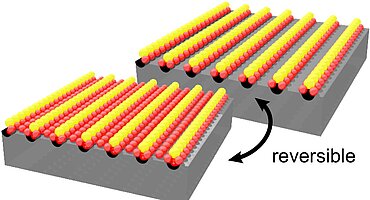Media
Image & Results Gallery (recent achievements)
Evidence for spinarons in Co adatoms
October 26, 2023
Single cobalt (Co) atoms on the (111) surfaces of noble metals are considered to be prototypical systems for the Kondo effect in scanning tunnelling microscopy experiments. Yet, recent first-principles calculations performed by our collaborators at Forschungszentrum Jülich and the University of Duisburg-Essen suggest that the experimentally observed spectroscopic anomaly characteristic for Co atoms can be interpreted in terms of excitations of the spin of the Co atom and the formation of a novel many-body state, namely, the spinaron, rather than from a Kondo resonance.
The spinaron is a magnetic polaron that results from the interaction of spin excitations with conduction electrons. The experiments performed by Felix Friedrich and Dr. Artem Odobesko provide the first evidence for spinaronic states in Co atoms on the Cu(111) surface. Spin-polarized scanning tunnelling spectroscopy measurements in high magnetic fields allow us to discriminate between the different existing theoretical models and to invalidate the prevailing Kondo interpretation. Extended ab initio calculations instead suggest the presence of multiple spinaronic states.
The results have been published in Nature Phys.
Reversible switching between spiral and collinear magnetic order via oxidation and reduction
February 23, 2023
The every-day ferromagnets we use magnetically order due to the exchange interaction, i.e., the overlap of electronic wave functions of neighboring atoms. It causes the spins to order parallel, and the superposition of their magnetic moments produces the magnetic field we hold characteristic for feroomagnets. Another, more complicated coupling is caused by the so-called Dzyaloshinskii-Moriya interaction. It causes the emergence of a wide variety of interesting magnetic structures, such as spin spirals and skyrmions. In a recent study, we showed by spin-polarized scanning tunneling microscopy that the interchain coupling between manganese oxide chains on Ir(001) can reproducibly be switched from chiral to collinear antiferromagnetic by increasing the oxidation state of MnO2, while the reverse process can be induced by thermal reduction. The underlying structure–property relationship has been revealed by low-energy electron diffraction intensity analysis performed by collaborators at FAU Erlangen-Nürnberg. Density functional theory calculations suggest that the magnetic transition may be caused by a significant increase of the Heisenberg exchange which overrides the Dzyaloshinskii-Moriya interaction upon oxidation. The results have been published in Phys. Rev. B 107, L060409 (2023).







